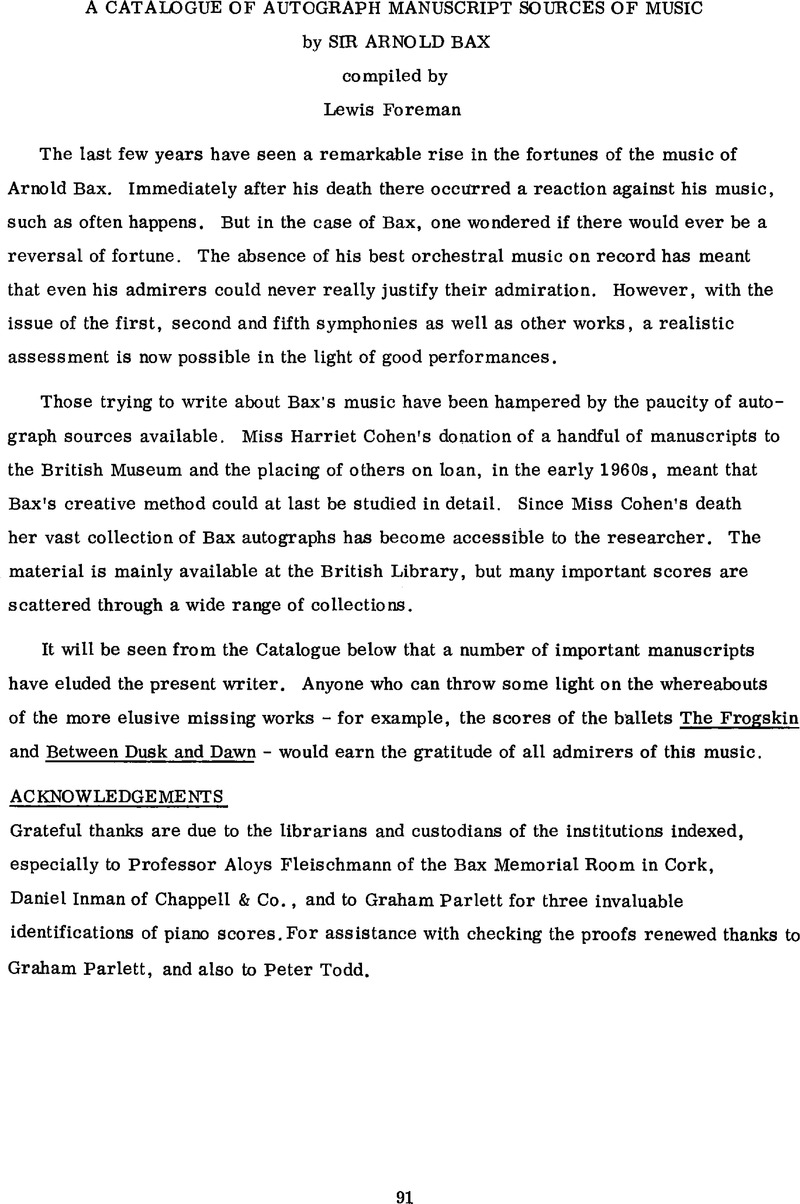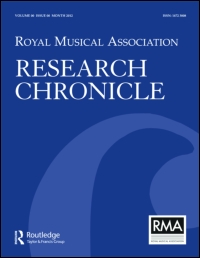No CrossRef data available.
Article contents
A Catalogue of Autograph Manuscript Sources of Music by Sir Arnold Bax
Published online by Cambridge University Press: 01 January 1974
Abstract

- Type
- Other
- Information
- Copyright
- Copyright © Royal Musical Association, 1974
References
∗ In the course of the Catalogue GB is omitted from sigla used for collections in Great Britain.Google Scholar
1 Purchased at Christies 18 Dec. 1968, lot 22. See my account in Music and Letters, Jan. 1971, pp. 60–61.Google Scholar
1 Not to be confused with the Chaucer Rondels (of 1914).Google Scholar
1 In his radio talk in 1949, Bax stated that he had never set Yeats observing that ‘he is too good'; however this and one other setting – To an Isle in the water – were made, but were never published, and presumably Bax regretted making the settings.Google Scholar
2 Song that appears in the novella by P. B. Jacobsen.Google Scholar
Chester own a printed proof of the song with the words deleted by Bax in longhand and new words by “Dermor O'Byrne” substituted.Google Scholar
The published score is marked as having words by “Anon”, and is called ‘The Enchanted Fiddle'.Google Scholar
1 Eire, part 1.Google Scholar
2 An Sluagh Sidhe – Eire, part 2.Google Scholar
3 Eire, part 3. A full history of this work and its relationship to the projected opera ‘Deirdre’ will be found in Graham Parlett's ‘Deirdre and Rosc-catha sic; Bax Society Bulletin, Nov. 1970, pp. 18–21.Google Scholar
1 Also known as King Kojata, which name has been added to the Ms in Bax's hand.Google Scholar
2 See Bax's account of the first performance of this work in Farewell my Youth, pp. 80–88.Google Scholar
3 Original version consists of: 1) Pensive Twilight; 2) Dance in the Sun; 3) In the Hills of Home; 4) Dance of Wild Irravel. In the revision 1) becomes (1) Evening Piece; 2) becomes (3) Dance in the Sunlight; 3) becomes (2) Irish Landscape; 4) is omitted.Google Scholar
4 Until an Ms score was found among Miss Harriet Cohen's papers, it was believed the work was unplayable, as the only known score had been destroyed in Chappell's 1964 fire. The work was finally premiered by Leslie Head and the Kensington Symphony Orchestra in December 1970.Google Scholar
5 Wanting a piano part.Google Scholar
1 First performed at Queen's Hall on 8 Apr 1921, with Ethel Fenton as soloist, when songs 1–5 were sung in the above order. Song no. 6 – the only one that demands a low male voice - has apparently never been performed. Bax's correspondence with Edward Clarke about the first performance will be found in the Edward Clarke letter books in the British Museum (Add Ms 52256). The work was revised at the end of the Second World War, and the revised version was published by Chappell in vocal score only. The songs were now in the order: 2) 1) 5) 3) 4). This version was given two broadcast performances by Emelie Hook, on the BBC Third Programme on 26 March 1949 and again on the Home Service the following day.Google Scholar
2 The work was eventually published by Murdoch in 1920, and was the only work by Bax to be republished by Chappell in a revised form. These revisions (1945) involve a cut in each of the outer movements and many close tempo and dynamic directions.Google Scholar
1 Not to be confused with the song of the same name (no. 39) which was published by Murdoch in 1923 under the title The Flute.Google Scholar
2 Shows cuts and additions not transferred to the published full score.Google Scholar
3 The same work that Grove5 lists as Scherzo (1913); the music originated as the Piano Sonata in F (no. 64)Google Scholar
4 The pianola roll was issued on a variety of numbers, and consists of a little less than the first half of the work. For the roll numbers see my discography of Bax, Recorded Sound, Jan-April 1968, pp. 277–83.Google Scholar
5 Gift from Dr Howard Ferguson.Google Scholar
6 The autograph full score was partly damaged by fire in the Second World War, when Miss Harriet Cohen's flat was bombed. 86(iv) is in a paper wrapper marked ‘discarded variation’ in Miss Cohen's hand. She, in fact, only once played the work including this variation; after the first performance it was always omitted until Patrick Piggott revived the complete score in 1963, and Chappell's published it thus. For a full history of the work see my article in Musical Opinion, March 1971, pp. 291–3.Google Scholar
1 The parts that have so far come to light are: first violin, viola, double bass, flute, oboe, harp, piano, tympani, side drum, cymbals, tambourine. Extensive cueing reveals intriguing snatches of others. The parts are split between two different private owners.Google Scholar
2 At the work's first performance at the Queen's Hall on 7 November 1921 (Tertis/Coates) the programme note was written by Bax and the work was described as ‘Concerto'. When it was next played at the famous 1922 concert of Bax's works, it was described as ‘Phantasy'.Google Scholar
3 Spelt ‘This World's Joy’ on the Ms.Google Scholar
1 Chappell & Co. have a photograph of a copyist's score.Google Scholar
2 The date is very difficult to decipher and the last figure could be 7 or 9.Google Scholar
This work has been described by some commentators as ‘Northern Ballad No. 3'.Google Scholar
1 Grove5 lists ‘Three songs with orchestra (1927)'. These appear to have been orchestrated in 1934, although whether as an integral set is open to question. A fourth song, Eternity, was also orchestrated at the same time and has been listed here for convenience.Google Scholar
1 'III Allegro’ is not positively identified as belonging to this work. However, the fact that it is in the same key, A-flat, would add some support to such an assumption.Google Scholar
1 Whether this is a transcript of an 18th-century work, as yet unidentified, or a pastiche is difficult to say. Graham Pawlett has identified a quotation from it in the slow movement of the Violin Concerto.Google Scholar


